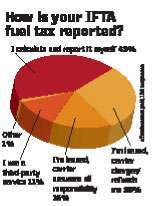
Many owner-operators would probably file their International Fuel Tax Agreement (IFTA) tax reporting process under the “necessary evil” heading. It’s tedious, and penalties apply for not filing. Fortunately, says Tennessee-based independent Michael Goodman, “doing your IFTA isn’t all that complicated, but it is time-consuming, especially if you wait until the end of the quarter to do anything.”
IFTA is all about record-keeping – tracking your truck’s average mpg and making correct notes of the number of gallons of fuel you buy, where you buy it and how many miles you run in any given state. You report all of this to the IFTA office in the state where you’re registered, and IFTA calculates the tax you owe to each state. It also redistributes the tax you’ve already paid at the pump to more closely reflect the miles you drove in a state.
Before IFTA was fully entrenched in the mid-90s, says 40-year industry veteran and owner-operator Gil Johnson, “you had to report to each individual state” and send in what you owed or request your refund if you overpaid – likewise to each state you ran in but didn’t buy fuel in. It consumed a lot of stamps – and time. Particularly head-aching was the wait on states to refund you.

While a single reporting state simplified the process, it didn’t make for a foolproof system. Because tax owed is based on average fuel mileage, “there is still an element of error in your real mileage,” says Goodman.

Idaho independent Randy Cox, whose base state doesn’t have an online reporting option, built his own spreadsheet for calculating his IFTA miles, as has Goodman. Both have embedded the calculations spelled out on the IFTA Form 150 into the spreadsheet cells to allow for easy computing.
Keeping accurate records and staying abreast of quarterly tax changes in states is key to making this system work. State updates are typically sent out to all IFTA account holders, but monitoring the main IFTA site (www.iftach.org) is advisable.
Owner-operators buying the majority of their fuel in high-tax states and running a majority of miles in lower tax states will be due a refund. The opposite is true. “We fill up a lot in Missouri and Wyoming,” says Cox, “which has the lowest tax rate of all the states. I usually owe a little bit. I’m down to one truck now, so in a quarter we might owe $100 or $200.”
Some carriers allow leased owner-operators the option of holding their own IFTA account, says Bob Pitcher, state laws vice president for the American Trucking Associations. “IFTA does give a fair bit of discretion to the lessor and lessee on who does the reporting, but it does need to say it in the lease contract.” Many fleets, he says, for reasons of fairness, “allow their owner-operators to do their own.”
What might be unfair about a fleet taking care of an owner-operator’s IFTA? Nothing, if there is no chargeback to the owner-operator. In such a case, your fleet is reporting your state mileage and paying it for you, and you’d be well advised to take the advice of the owner-operator financial services consultants at ATBS and buy fuel according to the cheapest pump price, regardless of taxes.
If you’re getting charged for IFTA underpayment by your carrier, however, and it’s charging you based on the fleet’s average fuel mileage, you could be paying too much in fuel tax because it’s based on mileage that’s less than yours.
Formerly leased owner-operator Ted Cekinovich wrote Overdrive about a similar problem he was having earlier this year. Cekinovich had averaged more than 8 mpg in his truck over several trips, but his fleet’s IFTA accounting software, apparently incapable of recognizing 8 mpg and above as valid, had defaulted to the fleet average, which was under 6 mpg. Essentially, Cekinovich on those trips was paying taxes on fuel as if he were running at the lower fleet average on those trips – amounting to several gallons extra, depending on the actual trip mileage.
Per-trip, the difference isn’t much. But consider the case of an owner-operator getting 8 mpg on 24,000 miles in a quarter, paying taxes on 3,000 gallons burned. If a fleet average of 6 mpg is used to determine what that operator owes, he’s effectively paying the carrier for taxes on an extra 1,000 gallons. Depending on what states he runs, that could be a net loss of a few hundred bucks a quarter.
Joel Baker, Clarksville, Tenn.-based independent owner-operator and co-creator of the TruckBytes software, which includes an IFTA accounting option, calls this the “most common abuse” of the IFTA system by carriers, though he acknowledges that one carrier’s approach may be different from another’s. “Unfortunately, many leased owner-operators come to realize it’s in their best interest to have their own IFTA accounts and their carriers don’t allow it,” he says.
There’s a solid reason for that, too. “A lot of fleets would want to do it themselves to make sure the fuel actually gets reported,” says ATA’s Pitcher. If the owner-operator is running under the fleet’s authority, the fleet is ultimately responsible for any unpaid taxes, even if the operator has his or her own IFTA account, he says.
Furthermore, Pitcher adds, a scenario opposite to the one described above is possible, too. “Sometimes the [leased] owner-operator might use the fleet average mpg” when reporting his own miles, particularly if it’s a higher rate. “But if they’re reporting their own, IFTA recognizes them as a separate fleet and they shouldn’t be using somebody else’s records.”
In the end, IFTA payment should be addressed in the lease contract; if it’s not, ask about it. Keep your own records and you can easily check to make sure you’re not being charged for taxes on gallons you didn’t burn.
High-tech options are available. “We have a lot of owner-operators who use TruckBytes’ IFTA function to monitor their own carrier,” says Baker. He notes the case of an operator who realized he was getting charged $200 a quarter as a sort of filing fee by his carrier.
“We have noticed an increase in carriers who are changing the way they charge owner-operators for fuel taxes, getting creative … to reduce overall IFTA tax due or to increase their profit margin,” Baker says. “I look at every settlement I get – if I’m going to check my paycheck, wouldn’t I be validating my IFTA as well?” he asks. “Those fuel taxes are my money, too.”
Building your own IFTA spreadsheet
This Microsoft Excel spreadsheet uses tax rates from the second quarter and mileage/fuel numbers from a hypothetical operator running between Fort Worth, Texas, and Charlotte, N.C., with a single trip between North Carolina and Indiana as well. The full spreadsheet would list all continental states and/or provinces.
1 Enter tax rates, expressed in dollars, from IFTA Form 105. If you’re running in Canadian provinces, be sure you’re using gallons, not liters. Note Kentucky, Indiana and Virginia have “surcharge” rates, representing tax not included in the pump price (create separate “surcharge” rows for each of those states). Compute your average fuel mileage for the quarter and copy in column C; enter miles run in each state in D column, duplicating miles in surcharge states’ two rows (to automate duplication, for example, use formula “=D5” for cell D6).
2 Enter formulas to add numbers in the columns, skipping surcharge rows [“=SUM(E3:E5, E7, E9:E14, E16)” for example]. Skip them in row-17 formulas in columns D, G and H, too. However, in F17 and I17 [“=SUM(I3:I17)” for example] include surcharge in total tax.
3 Divide D column by C column [“=(D3/C3)”] to figure gallons burned.












